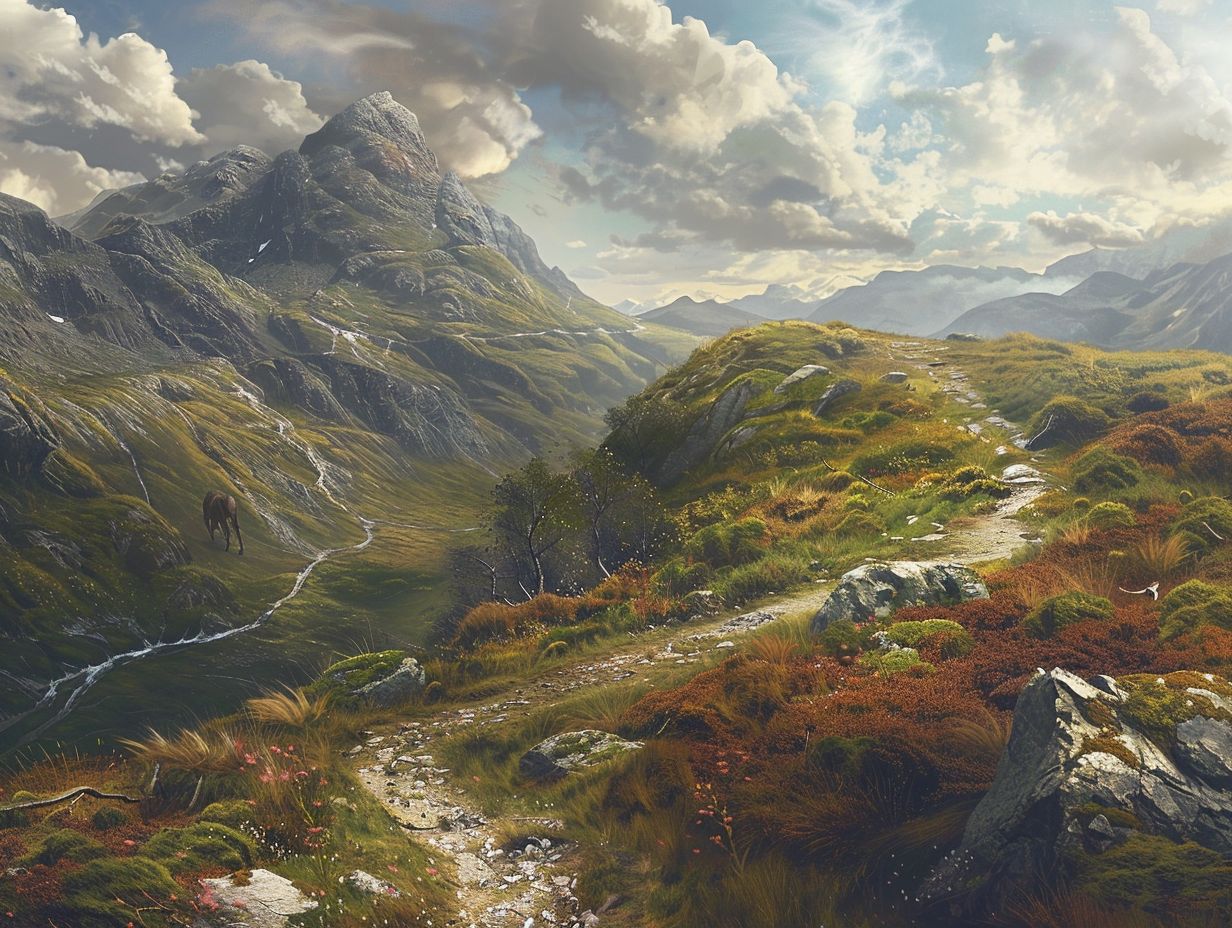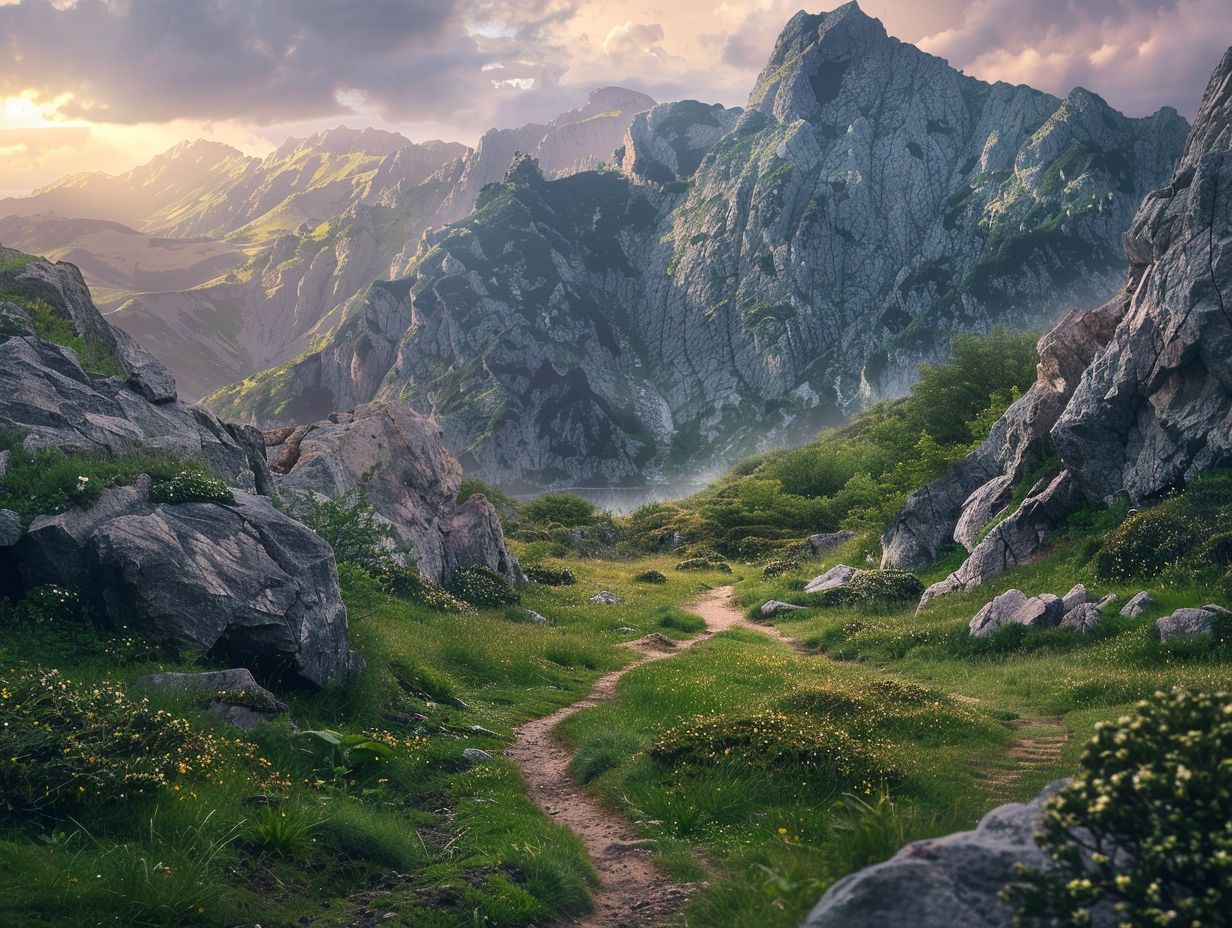Calling all nature enthusiasts and hiking aficionados! Are you ready to lace up your boots and explore the stunning landscapes of the Scottish Borders?
In this article, we will take you on a journey through the top hikes in the region, including the Southern Upland Way, Borders Abbeys Way, St. Cuthbert’s Way, John Buchan Way, and the Three Brethren.
Before you set off on your adventure, we will also cover the essential items you need for hiking and important safety precautions to ensure a memorable and safe experience.
Grab your gear and let’s hit the trails!
Key Takeaways:

- The Scottish Borders offer a variety of scenic and challenging hikes, including the Southern Upland Way and St. Cuthbert’s Way.
- Proper hiking gear, navigation tools, and first aid kit are essential items to have when exploring the wilderness in the Scottish Borders.
- Safety precautions such as checking the weather, informing someone of your plans, and respecting the environment and wildlife should be taken while hiking in the Scottish Borders.
What Are the Top Hikes in the Scottish Borders?
The Scottish Borders, renowned for its stunning landscapes and extensive history, presents an array of Scotland’s most enchanting hiking opportunities.
With its sprawling hills, tranquil rivers, and historic landmarks, the region offers a diverse selection of hiking trails suitable for both leisurely strolls and challenging hillwalking expeditions. This makes it a highly sought-after destination for nature enthusiasts throughout the year.
1. The Southern Upland Way
The Southern Upland Way stands as one of the most renowned long-distance hiking trails in the Scottish Borders, spanning the undulating hills and varied landscapes of Southern Scotland.
This 214-mile trail commences at Portpatrick on the west coast and culminates at Cockburnspath on the east coast, presenting a diverse range of terrains and ecosystems throughout its course.
Enthusiasts of trail running will find themselves captivated by the remote upland panoramas, rugged moors, ancient woodlands, and scenic valleys that characterise this trail.
Noteworthy landmarks along the route encompass the striking cliffs of St. Abb’s Head, the historically-rich town of Melrose featuring its ancient abbey ruins, and the serene woodlands of the Galloway Forest Park. The Southern Upland Way combines breathtaking scenery with formidable physical challenges, rendering it a gratifying expedition for outdoor aficionados.
2. The Borders Abbeys Way
The Borders Abbeys Way offers hikers an opportunity to embark on a historically enriching journey through the heart of the Scottish Borders, linking four ancient abbeys and providing an immersive walking experience.
These abbeys, including Jedburgh Abbey, Melrose Abbey, Dryburgh Abbey, and Kelso Abbey, hold significant historical significance within Scotland’s storied past. Serving as centres of religion, education, and authority, these abbeys played pivotal roles in shaping the cultural and heritage landscape of the country.
As individuals traverse along the picturesque route, they have the chance to appreciate the breathtaking natural beauty of the Scottish Borders, characterised by rolling hills and lush landscapes.
Simultaneously, they can delve deeper into the region’s intricate historical narrative. The seamless integration of nature and history along the trail enhances its appeal and continues to attract tourists in search of a distinctive exploration experience.
3. The St. Cuthbert’s Way
St. Cuthbert’s Way traverses a cross-border trail stretching from Melrose in the Scottish Borders to the Holy Island of Lindisfarne, offering hikers a captivating fusion of natural beauty and historical significance.
The trail features a diverse topography, encompassing undulating hills and coastal pathways, catering to hikers of various skill levels and providing a challenging yet gratifying trek. Throughout the journey, adventurers will encounter numerous historic sites, including dilapidated abbeys, ancient churches, and medieval edifices that recount narratives of antiquity.
The picturesque vistas along St. Cuthbert’s Way are truly awe-inspiring, presenting panoramic outlooks of the rugged coastline, verdant meadows, and serene rivers that evoke a profound sense of tranquillity and admiration.
Beyond being a mere passage through physical landscapes, this trail serves as a spiritual pilgrimage, tracing the revered Saint Cuthbert’s footsteps and encouraging introspection and meditation amidst the natural splendour of the surroundings.
4. The John Buchan Way
The John Buchan Way is a picturesque hiking trail, named in honour of the renowned author, which winds through the scenic Manor Hills and offers breathtaking panoramas of Eildon Hill and the surrounding countryside.
This trail not only serves as a physical expedition but also presents an opportunity for a literary voyage, reflecting the terrains that inspired the literary works of John Buchan.
While trekking through the verdant foliage and undulating hills, one can immerse themselves in the essence of his captivating narratives permeating the surroundings.
At every stride along the path, hikers will uncover concealed vantage points that exhibit the natural splendour of the region, ranging from serene meadows to ancient woodlands. The trail’s accessibility renders it a favoured choice among hikers of diverse proficiency levels, presenting an ideal mixture of challenge and serenity.
5. The Three Brethren

The Three Brethren, a renowned landmark in the Scottish Borders, presents an exhilarating hiking experience that offers participants panoramic vistas of the surrounding hills and valleys.
As individuals traverse the time-honoured pathway leading to the Three Brethren cairns, they are enveloped in a picturesque landscape of undulating green hills, interspersed with vibrant wildflowers and verdant forests.
The cairns, steeped in historical significance and traditional lore, function as a site for contemplation for many, symbolising harmony and camaraderie amidst the hills.
The challenging terrain poses a trial for hillwalkers and nature enthusiasts alike, with each stride unveiling the unbridled magnificence of the Scottish terrain. En route, the melodic calls of indigenous birds and the gentle rustling of the wind through the trees craft a tranquil backdrop to this indelible journey.
What Are the Essential Items for Hiking in the Scottish Borders?
When planning for a hiking trip in the Scottish Borders, it is essential to pack appropriate gear to ensure safety and comfort during the exploration of the region’s diverse natural landscapes and participation in a variety of outdoor activities.
1. Proper Hiking Gear
Proper hiking equipment is essential for any excursion in the Scottish Borders, ensuring both safety and comfort as one navigates the hills and walking trails of the region.
- Sturdy boots are imperative in providing the necessary ankle support and traction on varied terrains, thereby mitigating the risk of slips and potential injuries.
- Weather-appropriate attire, inclusive of moisture-wicking layers and a waterproof jacket, serves to shield individuals from the changeable Scottish weather.
- An appropriately fitted rucksack, equipped with adjustable straps, facilitates an even distribution of weight, thereby lessening strain on the back and shoulders.
- Additional crucial items include a map, compass, first aid kit, and an ample supply of water and snacks to sustain one throughout the expedition.
2. Navigation Tools
Navigation tools, such as maps, GPS devices, and compasses, are essential for hiking in the Scottish Borders, facilitating proper orientation and safe exploration of the trails.
Maps serve as visual aids, depicting the terrain with key landmarks and elevation changes. GPS devices provide real-time tracking capabilities, enabling precise location determination even in remote areas. Compasses are essential for orienting oneself to cardinal directions, ensuring constant awareness of northward orientation.
Through the integration of these tools, hikers can confidently navigate the diverse landscapes of the Scottish Borders, whether tackling rugged peaks or traversing wooded valleys. Proficiency in interpreting these tools is paramount for ensuring a successful and gratifying hiking experience.
3. First Aid Kit
It is crucial to carry a first aid kit as a safety measure for any hiking excursion in the Scottish Borders, enabling individuals to address minor injuries and medical concerns encountered along the trails.
It is advisable to include essential items like adhesive plasters, dressings, medical tape, antiseptic wipes, tweezers, scissors, gloves, and a CPR mask in your first aid kit. These provisions are instrumental in managing cuts, scrapes, sprains, insect bites, and other common injuries often associated with hiking activities.
If there is emergencies, the presence of a comprehensive first aid kit can play a significant role in delivering immediate care prior to the arrival of professional assistance. It is essential to acquaint oneself with the proper usage of each item within the kit to ensure proficient and timely aid whenever necessary.
4. Food and Water
It is essential to pack an adequate supply of food and water to ensure sufficient energy and hydration levels during hiking excursions in the Scottish Borders.
When preparing for hiking adventures, it is recommended to include lightweight, non-perishable snacks such as trail mix, energy bars, and dried fruits. These snacks offer a quick energy boost for sustained physical activity.
Additionally, incorporating complex carbohydrates like wholemeal crackers or nut butter sandwiches can provide longer-lasting fuel. Protein-rich snacks like jerky or cheese are also beneficial for muscle recovery.
Hydration is a critical aspect of hiking, so it is vital to carry a reusable water bottle or hydration pack. Regularly consuming water throughout the hike is advised to prevent dehydration. When selecting provisions, it is best to choose compact and easily transportable containers or pouches to optimise space in your backpack.
5. Emergency Shelter

An emergency shelter is a critical component to include in your hiking gear when exploring the Scottish Borders, as it offers protection in the face of unexpected weather conditions or emergencies.
There exist several types of emergency shelters on the market, which include lightweight tents, bivvy bags, and emergency blankets, each serving a specific purpose that aligns with the circumstances at hand.
Lightweight tents are suitable for longer stays or inclement weather conditions, bivvy bags offer portability and convenience during brief stops, and emergency blankets provide insulation and shielding.
Having the appropriate type of shelter readily available is vital to ensuring both safety and comfort during abrupt weather alterations that are commonplace in the Scottish Borders. Before embarking on any outdoor excursion, it is imperative to consult weather forecasts and equip oneself with the necessary emergency supplies to effectively manage any unforeseen events that may arise.
What Are the Safety Precautions for Hiking in the Scottish Borders?
Ensuring safety is of paramount importance when trekking the hiking trails of the Scottish Borders, considering the varied challenges and potential hazards that may be encountered within the region’s natural scenery.
1. Check the Weather
Understanding the weather patterns in the Scottish Borders is vital for hikers due to the region’s reputation for erratic weather. Sudden weather changes can affect visibility, trail conditions, and overall safety. Analysing the forecast enables hikers to prepare for various conditions, including mist, rain, or strong winds.
Prior knowledge of expected weather conditions give the power tos hikers to pack appropriate gear, such as waterproof coats, sturdy boots, and extra layers. Being aware of the weather not only enhances the hiking experience but also promotes safety on the trails.
2. Inform Someone of Your Plans
It is imperative to communicate your hiking intentions as a critical safety protocol whilst exploring the paths in the Scottish Borders. In unforeseen emergencies or situations that may arise, informing a trusted individual of your itinerary can prove to be a life-saving measure.
By disclosing essential information such as your planned route, estimated time of return, and emergency contact details, you are ensuring that prompt assistance can be dispatched if necessary.
This straightforward precautionary step can significantly impact the success of a rescue operation, particularly in isolated areas where communication or GPS signals might be unreliable. It is essential to prioritise safety above all else when embarking on outdoor excursions.
3. Stay on Designated Trails
Adhering to established trails is imperative for both safety and environmental preservation when engaging in hiking activities within the Scottish Borders.
Straying from designated paths not only presents potential hazards such as the risk of becoming disoriented or encountering perilous terrain but also disrupts fragile ecosystems and wildlife habitats. By adhering to marked trails, hikers contribute to reducing their environmental impact, thereby enabling flora and fauna to flourish without disturbance.
Maintaining adherence to specified routes ensures that visitors can fully immerse themselves in the natural splendour of the region without causing harm. Responsible hiking practices play a pivotal role in safeguarding the immaculate landscapes of the Scottish Borders for the enjoyment of future generations.
4. Be Prepared for Wildlife Encounters
Preparedness for wildlife encounters is essential to ensuring safety while hiking in the Scottish Borders, where a diverse range of fauna may be encountered.
Hikers in the Scottish Borders may encounter various wildlife species, including the majestic red deer and elusive mountain hares, during their excursions. It is imperative for hikers to remain composed and avoid sudden movements when encountering animals like the red deer, as these animals are typically more apprehensive of human presence.
Maintaining a safe distance and refraining from feeding or approaching wild animals is vital. Demonstrating respect for the natural habitats of these creatures is critical for upholding ecological balance and safeguarding their welfare.
5. Leave No Trace

Adherence to Leave No Trace principles is essential for the conservation of the natural beauty and integrity of the hiking trails in the Scottish Borders.
These principles are designed to minimise the impact of human activities on the environment, thereby promoting responsible outdoor ethics. By following Leave No Trace guidelines, hikers can contribute to the protection of wildlife habitats, water sources, and vegetation along the trails.
Simple actions such as properly disposing of rubbish, remaining on designated paths to prevent erosion, and observing wildlife from a safe distance can yield significant benefits. The implementation of these principles not only ensures the sustainability of natural landscapes but also enhances the overall hiking experience for both current and future generations.
Frequently Asked Questions
What are the top hikes in the Scottish Borders?
The top hikes in the Scottish Borders are the Southern Upland Way, the Eildon Hills, the Three Brethren, the Pennine Way, the St Cuthbert’s Way, and the Cheviot Hills.
How difficult are these hikes?
The difficulty level varies for each hike, but generally they range from moderate to difficult. The Southern Upland Way and the Pennine Way are longer and more challenging hikes, while the Eildon Hills and the Three Brethren are shorter and more moderate hikes.
What is the best time of year to hike in the Scottish Borders?
The best time to hike in the Scottish Borders is during the summer months (June-August) when the weather is milder and the days are longer. However, spring (April-May) and autumn (September-October) can also be good times to hike, but be prepared for cooler temperatures and potential rain.
Are these hikes suitable for beginners?
Some of these hikes, such as the Eildon Hills and the Three Brethren, are suitable for beginners as they are shorter and less challenging. However, the Southern Upland Way and the Pennine Way are more suitable for experienced hikers due to their length and difficulty level.
Is it necessary to hire a guide for these hikes?
No, it is not necessary to hire a guide for these hikes. However, if you are unfamiliar with the area or are a beginner hiker, it may be beneficial to hire a guide for safety and navigation purposes.
What should I bring with me on these hikes?
It is important to bring proper hiking gear, including sturdy hiking boots, plenty of water, snacks, a map or GPS device, and appropriate clothing for the weather. It is also recommended to let someone know your hiking plans and have a charged phone for emergencies.

